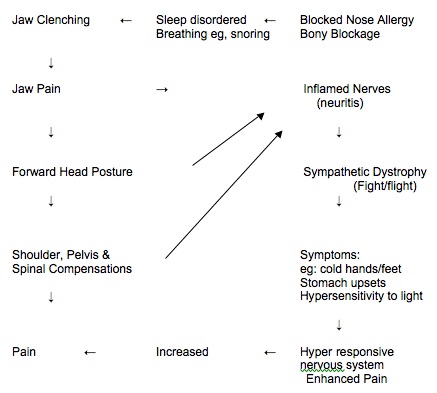Headaches, Backaches and Dentistry

Introduction
About 1/3 of the population suffer from Musculo–skeletal problems and imbalances. Frequently these problems can cause pain. Most of us know of people with chronic pain headaches, back aches or neck pain and migraines
Usually people see chiropractors or osteopaths for the spinal issues. They may see a dentist for the headaches. Commonly people self medicate (eg: Nurofen) to manage pain. People often report that their back is okay if they have weekly adjustments. If they stop they regress as the adjustments ‘do not hold’. As a dentist I used to be happy with 60-70 % success with headache treatment using traditional TMJ therapy. What I did not ask was if their back pain was still present. Now we consider it all.
Advances pioneered by Dr Olmos (dentist) and Dr John Beck (orthopaedic surgeon) have now changed this. Dr Beck has developed some motor reflex tests that enable us to talk to the nervous system directly to find out what is the main concern or stressor to the system. We can then target the cause using the appropriate modality be it dentistry or a physical therapy.
This is an important ability not possible in the past. With chronic pain the part that hurts is rarely the cause of the pain eg: if you have a sore right foot you transfer weight to the left foot and soon it will become the sorest foot (with over use). The real cause of the pain therefore is the opposite foot to that which you complain about. The usual scenario is that the practitioner treats the area you complain about. That works with acute pain eg, abscessed tooth or broken finger. It rarely works with chronic pain or conditions as the part that hurts is not the cause (but a symptom).
The new motor reflex tests (which are not kinesiology) are based on the primitive reflexes your neurologist uses on the newborn. People normally grow out of these reflexes but when the system is chronically stressed (dystrophic) the nervous system regresses and these reflexes reappear and can used to pinpoint the stressed area.
Approximately 30% of people with head, neck and low back pain have the cause in the Temporo–mandibular joint (TMJ) just in front of your ear. If this is the cause we can treat it. If it is a symptom we refer to the practitioner most qualified to treat the primary cause. It is easy to work this out with the reflex tests. So the right practitioner treats the right area and success is therefore greater.
The usual sequence of events (in TMJ cases) is that the person clenches or grinds and develops painful jaw joints. To protect the joints they unconsciously move their chin forward and adopt a forward head position. The top of the back of the neck is constricted and this can refer pain to the forehead ie: frontal headaches.
Simultaneously the distortions is the neck create compensating shifts in the shoulders, spine and lower back and the problem spreads ie: we have a cause for the low back pain that is a long way from the low back. This is why treatment aimed at the low back pain often only temporarily “holds” as only the symptoms is being treated.
If we wish to treat such a TMJ cases we would place appliances to decompress the joints and protect them (especially during sleep). Often the forward head position can then resolve in days but it commonly takes a week or two.
The TMJ is no longer the cause, now the compensation eg. tilted shoulders or the low back can now unravel and I use chiropractors/ osteopath or physiotherapist skilled in the sacro-occipital technique to help heal and “unstick” any recalcicrant areas.
Often the secondary areas involve peripheral nerve entrapments in the feet or hands.
We keep testing and treating the ever more minor compensations and if properly done the treatment holds.
Neuritis
The pain in the TMJ is from tissue trauma and inflammation. When the head moves forward, nerves in the neck are traumatised and become inflamed.
The inflammation in these nerves is now known to spread along the nerves and along nerves connecting to them.
When this is prolonged (as in chronic pain) the nerves becomes sensitized and at a certain point the system goes into Reflex Sympathetic Dystrophy. This means the nervous system stays in sympathetic (or fight/ flight) mode. The symptoms here are broad but routinely you may experience cold hands and feet, dilated pupils (do not like glare), stomach upsets and adrenal overload as your system is overloaded with adrenal stress hormones eg Cortisol. Cortisol disrupts sleep.
However, if we can treat the cause that initiates the structural imbalances (forward head position and spinal compensations) and reduce inflammation of the nervous system people can get some rest. Their ability to cope with stress (adaptive range) increases. Frequently sleep improves. Correct jaw positioning and the consequent changes in the position of the cranial bones can improve nasal and pharyngeal airways. This can improve snoring and sleep apnoea issues
It is important to note that the jaw is important only in about 1/3 of chronic pain cases. The new reflex tests enable this to be precisely determined. Unnecessary dental treatment is thus avoided.




